South African Wheel Tank Rooikat
The story of Rooikat
Understanding that the Eland 90 cannon-wheeled armored car (the licensed version of the AML 245 family of French armored cars) is becoming obsolete has come to the South African military as early as 1968. It took two years of border war in Namibia, which in those years was a colony of the Republic of South Africa. The fighting confirmed that Eland armored vehicles had insufficient maneuverability in off-road conditions and were vulnerable to enemy fire, their armor could not withstand even large-caliber machine guns, and in conditions of close combat even armor-piercing bullets of rifle calibers were dangerous for the machine and crew. The maximum thickness of the Eland armor does not exceed 10 mm.
The fighting against the Angolan army confirmed that the Eland 90 is not effective enough against enemy tanks, as the South African military would like. The armored car cannon easily penetrated the T-34-85 tanks, but against the more sophisticated Soviet post-war production vehicles, the T-55 and T-62 were not effective enough. The use of cumulative projectiles made it possible to hit targets that had 320 mm of armor (located at an angle of 90 degrees), but not in all cases the penetration of the tank caused its failure. At the same time, any 100-mm or 115-mm tank projectile hit the Eland 90 armored vehicle guaranteed to lead to its complete destruction and death of the crew. The same was true for more modern South African armored vehicles Ratel. At the same time, the most terrible enemy of South African wheeled armored vehicles was even for tanks, and the much more common and unobtrusive 23-mm automatic guns - ZU-23, 23-mm projectiles of this installation without any problems affected all types of South African armored vehicles.
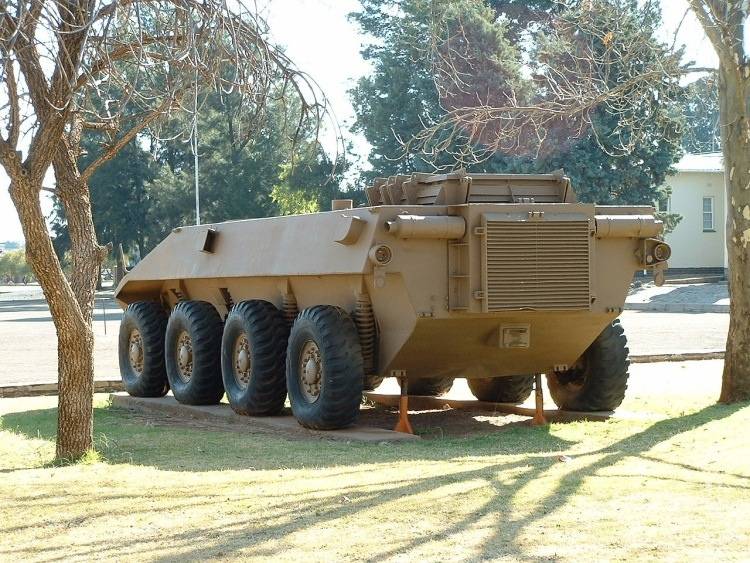
Summarizing the combat experience gained, the military leadership of South Africa already in 1974 year formulated technical requirements for the creation of a new wheeled armored car, which was to be the vehicle of a new generation. The main requirements for the new armored vehicle were: booking, reliably protecting frontal projectiles from 23-mm Soviet cannons; the presence of a diesel engine; the presence of long-barreled 76-mm or 105-mm guns, allowing you to hit tanks T-55 and T-62 from a distance of up to 2000 meters; The maximum travel speed is about 100 km / h, the power reserve is 1000 km. In addition, it was especially noted that the new armored vehicle should surpass the previous models in maneuverability, mobility and maneuverability.
Already by 1976, the South African designers prepared three concepts for the future of the armored vehicle. At the test, the new technique was released in 1978, the test lasted for about a year. The result was the choice of the concept number two, with the designation Eland Rooikat. This combat vehicle was distinguished by better booking and most closely corresponded to the wheeled tank concept. By 1983, the last prototype of the future serial wheel armored car Rooikat was ready. The tests, which lasted until 1987, ended with the adoption of a new armored vehicle for the South African army. In total, during the mass production in South Africa, approximately 240 of such wheeled tanks were assembled.
Design features armored car Rooikat
All Rooikat armored cars are built on the 8x8 wheel formula, while the crew has the ability to switch to 8x4 mode. The combat weight of the car turned out quite impressive and reaches 28 tons. Given the mass of technology and the requirements of the military, the designers paid much attention to the suspension and its survivability. The armored vehicle is able to move even with the loss of two wheels from one of the sides. During the tests, one of the cars made many kilometers of forced marches over the savanna with the missing front wheel, which had no effect on the mobility of Rooikat.
The wheeled tank Rooikat has a classic layout. In the front of the combat vehicle, there is a control compartment, in the middle of the corps there is a combat compartment, which is crowned by a rotating tower of 360 degrees, and in the rear part of the corps is the engine compartment. An automatic fire extinguishing system was placed in the fighting compartment and in the MTO, which increases the survivability of the armored vehicle in combat conditions. Steel homogeneous armor in the frontal part of the body provides reliable protection against Soviet 23-mm armor-piercing ammunition, released even at close range. The onboard armor provides protection of the car against fire from small weapons, and also splinters of artillery shells. In the sides of the hull between the second and third axles are hatches that are designed for emergency escape of the armored vehicle. The bottom of the armored car has mine protection. The tests carried out show that crew survival is achieved by undermining Soviet-made TM-46 anti-tank mines.
The driver's seat was located in front of the combat vehicle in the center. Above his seat there is a hatch allowing to leave the wheeled tank, in the hatch three periscope observation devices are installed. In the stowed position, the mechanic drive could operate the combat vehicle using the half-open hatch. In the tower are the seats of the three remaining members of the crew. The commander is sitting on the right side of the 76-mm guns, at his disposal there is a commander's cupola, in which the 8 fixed observation instruments are installed. To the left of the gun there is a gunner's place, at the disposal of which there is a GS-35 periscope sight with an integrated laser range finder. The sight is mounted on the turret roof and has two channels (a daytime 8 multiple channel and a night 7 multiple channel). In addition, the gunner also has a telescopic 5,5-multiple sight. Also in the tower is a loader, so the crew of an armored car consists of four people.
The heart of a wheeled armored car is a 10-cylinder turbocharged diesel engine delivering maximum horsepower 563 power. The engine is paired with an 6-speed automatic gearbox. Engine power is enough to accelerate an armored vehicle with a combat mass of 28 tons to 120 km / h (when driving on the highway). When driving off-road, the maximum travel speed does not exceed 50 km / h. The Caracal diesel engine, transmission and cooling system are designed as a single unit, this solution simplifies the process of replacing the entire power plant in the field. Cruising on the highway is approximately 1000 km.
The main firepower of the Rooikat wheeled tanks was the long-barreled 76-mm GT4 cannon, which is a variant of the naval artillery OTO Breda Compact. A distinctive feature of the weapon is the barrel length in 62 caliber. For comparison, the most massive German tank of the Second World War period had a long-barreled 75-mm cannon barrel length in 48 calibers, and in Soviet T-34s armed with X-NUMX-mm F-76 guns, the barrel length did not exceed 34 caliber. When using armor-piercing explosive sub-caliber shells (BOPS) with a 41,5-mm tungsten core, the South African GT76 gun could hit T-4 / 54, T-55 or M-62 tanks in any projection on the 48-1500 units, and 2000 meters. The tool pointing angles were quite comfortable and ranged from -3000 to + 10 degrees.
The fate of the project Rooikat
Despite the fact that for the South African army, the wheel-mounted armored car Rooikat was released in a rather large series of 240 units, the car didn’t have much success on the international market, and practically did not have to take part in military operations. Over the 15 years that have passed since the issuance of the technical specification to the introduction into service in 1989, a lot has changed in the world. The war in the region came to an end, and more modern and heavy armored vehicles appeared in the armament of the countries of the neighbors of South Africa. At the same time, the Rooikat armored vehicles were being upgraded, and the role of such vehicles on the battlefield was changing.
Initially, they were considered by the South African military as full-fledged wheeled tanks or tank destroyers that could fight the enemy’s T-55 and T-62 tanks. But over time, their role on the battlefield shifted to maintaining active, combat intelligence. The secondary role is combat support of infantry units and counterguerrilla warfare. The machine is still suitable for sabotage raids to the rear of the enemy or deep flank coverage, but fighting the enemy’s armored vehicles has become a much more difficult task, often unpromising. Like a wheeled tank, the Rooikat armored cars with a long-barreled 76-mm cannon no longer meet the challenges of time, while remaining a rather formidable fighting vehicle.
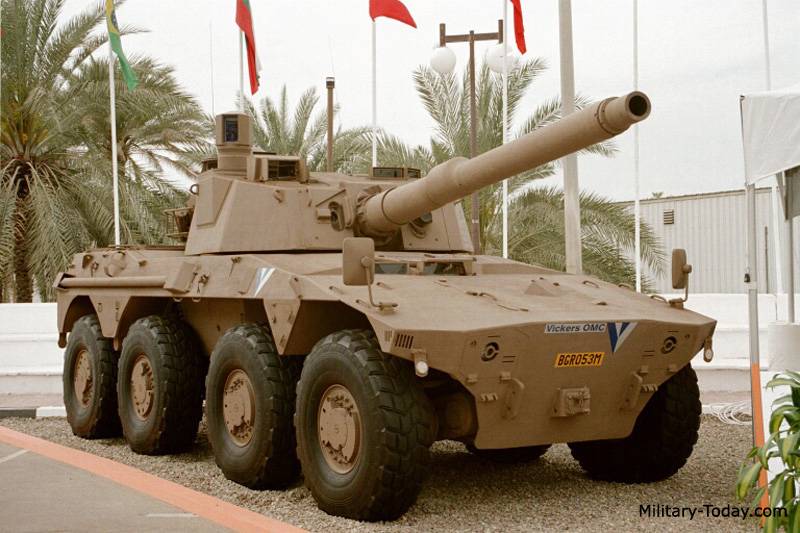
In South Africa, there were a large number of options for upgrading the Caracal, including the creation of a tank destroyer armed with a rifled 105-mm gun, but such a model was built in a single copy, the new armored vehicle did not find buyers in the international arms market. The tank destroyer with the 105-mm gun was fully prepared for the 1994 year, and the end of the Cold War and the glut of the market with armored vehicles from different countries (first of all, the USSR and the socialist camp) had a negative effect on his fate. In addition, South African engineers have created several projects of reconnaissance vehicles and self-propelled anti-aircraft installations based on Rooikat. These developments also did not shoot at the international market, where many countries preferred to them the time-tested (one might say older), but also cheaper Soviet-made armored vehicles.
Rooikat performance characteristics:
Wheel formula - 8x8.
Overall dimensions: body length - 7,1 m (with a tool - 8,2 m), width - 2,9 m, height - 2,8 m.
Combat weight - 28 tons.
The power plant - 10-cylinder turbocharged diesel engine with horsepower 563.
Maximum speed - 120 km / h (on the highway), 50 km / h (rough terrain).
Power reserve - 1000 km (on the highway).
Armament - Denel GT76 4-mm cannon or Denel GT105-7-mm gun and 2x7,62-mm machine gun.
Ammunition: 48 shots (76 mm) or 32 shots (105 mm), more 3000 cartridges for machine guns.
Crew - 4 person.
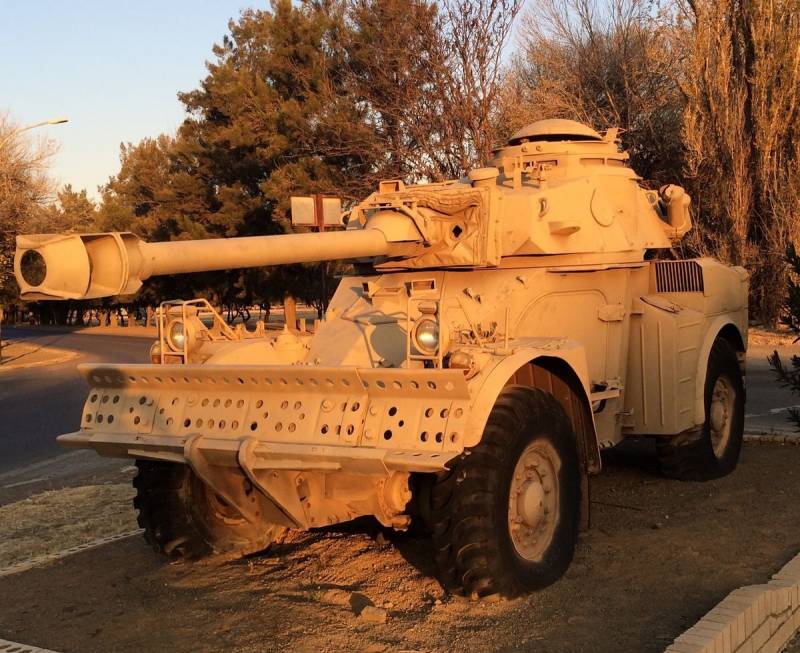
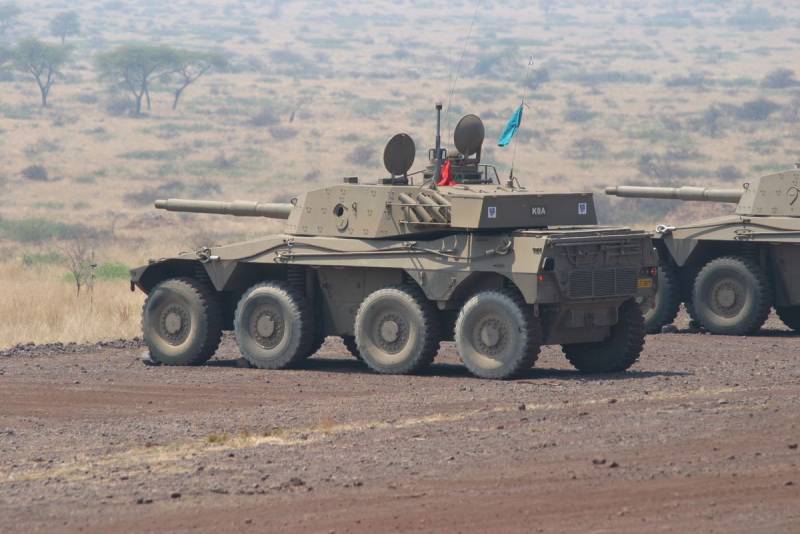
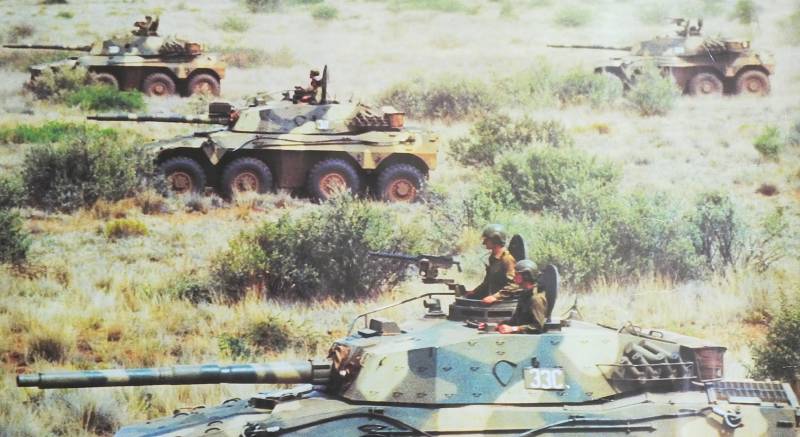
Information